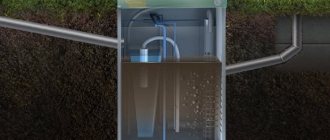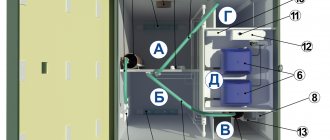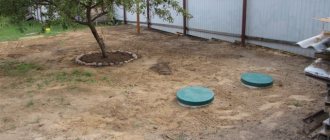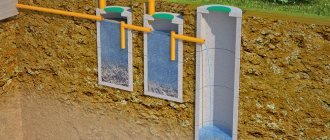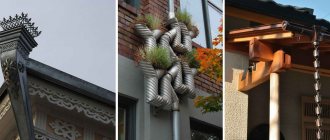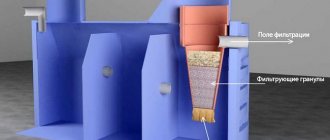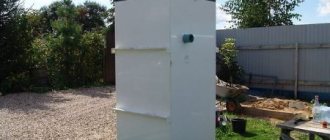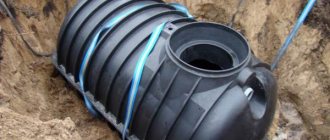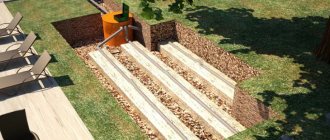When arranging an autonomous sewage system for a suburban area, many owners solve the issue of biochemical wastewater treatment by constructing systems based on stations, of which Topas belongs.
But how does this treatment plant work and how is the Topas septic tank installed? We will consider these issues in detail in our article, focusing on the step-by-step process of installing a septic tank.
We will also highlight the main advantages and disadvantages of this type of sewage disposal facility and the features of its maintenance, supplementing the article with step-by-step photos and useful video recommendations.
Advantages and disadvantages of the structure
The main advantage of the system is that each stage of cleaning occurs without polluting the environment.
Among the undeniable advantages of the system it is also worth highlighting:
- High cleaning efficiency.
- Economical power consumption.
- No noise during operation.
- Easy to care for.
Thanks to its compact dimensions, the treatment plant can easily fit even in a limited area.
A significant disadvantage of the structure is its energy dependence, which is associated with the operation of the compressor. The lack of uninterrupted power supply at the site makes the operation of the biological treatment plant impossible. Therefore, it is recommended to supplement the standard equipment of the station with an autonomous generator in case of interruptions.
It is also recommended that during long-term power outages, reduce water consumption so as not to overfill the station with untreated wastewater, which can spontaneously be disposed of when the volume increases and contaminate the soil.
The septic tank is equipped with technical devices that may become unusable if the station is flooded with surface water during floods. If similar phenomena are observed in the installation area, it is better to place the upper part of the station with the lid above the zero ground level
A significant disadvantage of such ready-made structures is their high cost. But when recalculating the savings in servicing with vacuum cleaners, it is immediately clear that the investment will pay off quickly.
And a pleasant bonus will be the absence of unpleasant odors and the ability to position the structure close to the house, which is so important when arranging a small area.
Connection of the TOPAS installation to the sewerage system
The entry depth of the supply pipe depends on the installation model and is indicated in the diagram. To facilitate installation of the supply pipe, the unit is supplied without an inlet socket. When the installation is fixed in the prepared pit, a hole in the wall of the receiving chamber is cut out according to the diagram. Optimal operation of the installation will be ensured by connecting the supply pipeline 1,500 mm above the bottom of the WWTP; this will ensure a good cumulative volume of salvo discharge and will help to avoid backwater in the pipeline.
The cut hole must exactly match the profile of the sewer pipe, then it is scalded with a welding rod.
Important conditions: the entrance is inserted into the receiving chamber, the entrance corresponds to the WWTP model, the supply line must be made of PVC pipe 110x3.2 mm or PVC 160x3.6.
Subtleties of choosing a septic tank wisely
The commercially available models of this cleaning station differ in power. Thanks to the wide model range, you can choose a design whose parameters will fully meet the customer’s needs.
For furnishing private houses, models with a numerical index of 5.8 and 10 are most often chosen. The Topas-5 model has a capacity of 1 cubic meter and is designed for a salvo discharge within 0.22 cubic meters.
The productivity of Topas-8 is 1.5 cubic meters, it copes with a salvo release in the region of 0.44 cubic meters. The Topas-10 model successfully operates with a productivity of 2 cubic meters, and its salvo release volume is 0.76 cubic meters. meters.
The numerical indicator in the name of each model indicates the maximum number of users for which the local treatment station is designed
Topas-5 is chosen for arranging an autonomous sewer system for small houses with no more than five residents. This does not take into account a large number of plumbing fixtures.
For large cottages, the number of households in which reaches 8 people, choose a septic tank with increased productivity - the Topas-8 model.
If you plan to connect several washing machines and install a jacuzzi in addition to a shower cabin, choose the model of the following modification Topas-10.
Each model has two modifications, differing in height:
- Standard - involves inserting a sewer pipe at a depth of 0.4-0.8 meters.
- Long - for deepening a sewer pipe up to 0.9-1.4 meters.
For areas where the geological section is represented by soils with low filtration properties, it is worth choosing models equipped with a pump. They provide a forced system for the removal of treated wastewater to the disposal site. Such modifications are marked “PR”.
Before installing Topas
Before starting work, you should read the instructions. The Topas septic tank does not have an inlet for connection to the sewerage pipeline. During installation, the pipeline is inserted into the receiving chamber of the installation and after that a hole is cut exactly according to the diameter of the pipe.
Subsequent sealing of the connection is carried out by soldering using a technical hair dryer and a 7 mm PP welding rod.
The pipe for gravity-flow installation models is available with a cross-section of 110 cm; in models where the ejection is forced, the pipe cross-section is 25 or 3 mm. The depth of the pipe outlet is at least 2,100 mm.
The installation cover, together with the hinges, should rise 150 mm above the ground level. Exhaust gases are ventilated through the sewer supply pipe, then through the riser. The vent riser is led directly to the roof or to the top point of the sewer system. Ventilation and sewage shafts must not be combined.
Key points for structural maintenance
The service life of the Topas system is more than ten years. But the key to the smooth operation of a structure is its proper maintenance. The operating requirements for any type of treatment plant are the same.
From the moment the septic tank is launched, it takes about three weeks to form an active biomass; to speed up the process, ready-made river sludge can be placed in the chamber
When operating such a treatment system, it is allowed if the wastewater contains residues of gentle detergents and phosphate-free washing powders. The presence of toilet paper residues in wastewater will not cause any particular harm.
When servicing a Topas septic tank, it should be taken into account that it is strictly forbidden to dump into it:
- Spoiled vegetables and fruits.
- Remains of building materials, including sand.
- Detergents with a high content of chlorine.
- Automotive consumables.
- Residues of medicinal preparations.
- Rubber, film and other synthetic compounds that are not biodegradable.
It is also not recommended to discharge water that has been purified using an oxidizer into a septic tank. If the operating rules are repeatedly violated, breakdowns are possible and then repair of the Topas septic tank will be required.
To avoid troubles, in addition to proper operation, it is necessary to regularly perform maintenance activities on the treatment plant. So, once a month it is necessary to clean the coarse filter. Once a quarter, remove waste sludge from the stabilizer. Replace the membrane annually.
Comprehensive preventive cleaning of the bottom and walls of the structure from silt sediment should be carried out every three to four years.
The accumulated stabilized sludge is pumped out from the fourth chamber with drainage sediment, it is used as a starting material for making compost or for direct fertilization of garden beds
A complete general cleaning of the septic tank, including checking the float mechanism and replacing the aerator, is performed once every ten years.
Maintenance activities for the Topas septic tank in winter have their own characteristics. We examined them in detail in this article.
Types of sewer water seals
Rice. 3 Knee siphons
Knees for bath
In appearance, knee models of hydraulic valves resemble the letter U; the unit is characterized by a simple design and high strength. The main installation locations for U-shaped elbows are under the bathtub; in the toilet, a similar water seal is built into the structure.
Knee siphons can be made small in height, unlike bottle siphons - this expands their scope of application from sinks to installation under bathtubs that have a low drain pipe. The disadvantages of the devices include inconvenience in maintenance - in order to remove dirt and debris that has settled to the bottom, you have to completely dismantle the device.
Rice. 4 Construction of bottle siphons
Structurally, they are made in the form of a cylindrical settling body with an upper and side outlet, which has a screw-on lid at the bottom. During operation, water enters through the inlet pipe into the volumetric flask, and after filling it, it pours out through the side outlet - the water seal provides the liquid remaining in the flask of the device.
Due to ease of maintenance, bottle siphons are installed under kitchen sinks and washstands in bathrooms, where there is enough space under the sinks to accommodate their rather voluminous and vertically elongated body. The disadvantages of siphons of this design include the impossibility of cleaning the sewer pipeline with a plumbing cable through their body - the device must be dismantled, freeing the pipeline, after which the necessary work is carried out.
Rice. 5 Types of siphon corrugations
One of the simplest and most universal options for organizing a water seal is to use a piece of flexible corrugated pipe, which is bent in the shape of a U, like an elbow. When the outlet pipe of the corrugation is lowered down, an S-shape appears.
The corrugation is good for its versatility - the bend can be made in any convenient place, it is easy to connect to the drain hole and sewer pipe at any relative location and distance due to the ability of the corrugated shell to stretch and easily change its direction. A plastic holder is included to keep the shape unchanged.
The main disadvantage of a corrugated water seal is the high hydraulic resistance to water flow and the ribbed inner shell, in the grooves of which dirt accumulates intensively.
Rice. 6 Overflow siphons for shower bowls - design
If any debris or small valuable items get into the shower tray, they can be easily removed by removing the cover along with the inlet pipe and pulling the glass containing the items out of the siphon assembly. The designs of overflow shower siphons are quite varied; they are all united by a round chrome-plated lid, which provides a side drain and is comfortable to stand on, as well as a low body.
Rice. 7 Parts of the shower overflow siphon
Bath drains
In bathhouses, steam rooms and saunas with a shower, in places where stormwater accumulates, water collects from a large area, so to bring it to the drainage point, the floor is made with a slope, and a drain is placed in the center. The standard device is a small-volume chamber into which water enters through the upper grill and pipe, after which it overflows through its edges or upper outlets and then follows the pipe.
The design is in many ways similar to bottle-type siphons, but does not have a lower removable lid for removing debris, since the body of the device is placed (walled up) in a screed. Dirt usually collects in the inner cup, which is easily removed from the device body.
Rice. 8 Operating principle of drain valves
Features of gas connections
When connecting gas stoves, water heaters and other types of equipment, flexible hoses are also used. Unlike water models, they are yellow and are not tested for environmental safety. For fixation, end steel or aluminum reinforcement is used. There are the following types of devices for connecting gas appliances:
- PVC hoses reinforced with polyester thread;
- made of synthetic rubber with stainless steel braid;
- bellows, made in the form of a corrugated stainless steel tube.
The Santekhkomplekt holding offers engineering equipment, fittings, plumbing fixtures and devices for connecting them to communications. The assortment is represented by products and materials from well-known foreign and domestic manufacturers. Discounts apply for bulk purchases, and product quality is confirmed by standard certificates. For information support and assistance, each client is assigned a personal manager. The ability to arrange delivery within Moscow and to other regions of the Russian Federation allows you to quickly receive the purchased goods without unnecessary hassle.
Upon completion of the technological and production tasks associated with the arrangement of a sewer system in an apartment building, industrial building, as well as in a private household, it is necessary to test the involved system using the forced flow method. This task is used to identify possible defects or improper installation of the entire involved sewerage part, and the test report for internal sewerage and drainage systems will be material evidence of the work on acceptance of the facility.
A visual inspection should be accompanied by inclusion in the test report of internal sewerage and drainage systems according to SNIP, which is currently represented by the current regulations of the “D” series appendix, which corresponds to SP 73.13330.2012 “Internal sanitary systems of a building”, recently a new one has been applied updated working edition according to SNiP 3.05.01-85.
German quality is beyond any doubt, and any product or thing from Germany means high quality and reliability. Exactly the same words can be applied to Marley gutters. High-quality and reliable operation of a house depends, first of all, on the roof structure, which must not only be correctly assembled and designed, but also meet high drainage requirements, and only the Marley drainage system can cope with the task with a “five” rating. Rain, rain, heavy snow, melting during the spring, and other factors are mandatory for a quality roof, and only a reliable drainage system can minimize all the risks associated with draining water through gutters and downpipes.
Why is it important to contact specialists?
As can be seen from everything described above, installation of Topas septic tanks is a complex, labor-intensive job that requires appropriate knowledge, level of training and significant experience. Today, thanks to the presence of social networks, various thematic blogs and videos in them, many buyers try to do even complex work on their own. However, as practice shows, in most cases, a home-made installation contains many errors and often becomes the main cause of sewage failure.
To avoid huge financial costs, fines and other problems, we suggest you contact specialists. Our company has been installing Topas septic tanks for a long time, so we have well-established work schemes, all the necessary equipment and a precise understanding of each stage of installation. With us you will receive a ready-to-use cleaner in the shortest possible time. We always take into account all the wishes of the customer, treat each project with great attention and carry out the work with great care.
After contacting us, our employees visit the site, help you choose a septic tank if necessary, and then formulate possible engineering solutions and provide them to the customer. The optimal installation option for the product is determined jointly. During their work, employees use components from proven, reliable manufacturers. The arsenal includes pipes, couplings, adapters, drains, sealants, and insulation materials only from well-known European and Japanese companies. Our clients can buy a Topas septic tank with installation.
The presence of all the necessary components, a clear work plan and constant cooperation with the customer helps us carry out installation at any site in a short time and at the most favorable price for the customer.
The process of digging a pit
To install a Topas septic tank, a pit is required. But before digging it, experts take into account several important factors, namely:
- soil type;
- climatic features of the region;
- depth of soil freezing in the cold season;
- installation depth of conductive pipes;
- sewerage model chosen by the customer for installation;
- the amount of wastewater processed by the septic tank per day;
- groundwater position.
There are also several methods for obtaining a pit, and the choice of each of them depends on the characteristics of the site and the location of buildings and plantings on it. The pit can be dug manually or using special equipment. Of course, using technology is the preferable option, because in this case it is possible to obtain greater accuracy, and most importantly, get the job done much faster. However, the cost of installing a Topas septic tank in this case is higher.
Experts calculate the parameters of the future pit, taking into account the dimensions of the septic tank, the presence of a concrete pad and the cover of the product, and determine its width and height. After determining the dimensions of the pit, a place to dig a trench is selected, its depth and angle of inclination are taken into account. In the case of clay soil, the creation of a pit has its own characteristics, because clay soil can absorb only 25 liters of water per day, while the absorption capacity of sandy soil is 90 liters per day. Taking this feature into account, engineers propose concreting the bottom of the pit and making a separate container or well to receive the resulting water. It is also known that clay is capable of changing its structure during cycles of freezing and thawing, and can simply move the septic tank from its installation site. Therefore, when installing the purifier in this type of soil, steel cables, loops, protrusions, etc. are used.
Quicksand is considered one of the most difficult types of soil. This is a type of soil that is saturated with water. In its properties, it resembles a clay type of soil, however, digging a pit and installing a septic tank in such soil is much more difficult. While digging a pit, specialists periodically pump out the water accumulated at the bottom. After the process is completed, workers install the formwork. For this purpose, boards and beams are used. They are installed along the entire perimeter of the pit as closely as possible to each other. Installation of the Topas septic tank is carried out as if in a frame built from boards; in this case, the creation of a cement pad is not required.
Turnkey installation
Turnkey installation of a septic tank. “Turnkey” means installing the equipment entirely by our company, i.e. excavation work, loading and unloading work, commissioning, installation, plumbing, etc. work will be done by our company.
Turnkey installation includes:
1) Delivery of a septic tank (up to 50 km, from the Moscow Ring Road, delivery is free, over 50 km, from the Moscow Ring Road, check with our specialists);
2) Digging a pit for a septic tank;
3) Digging a pit for concrete rings (if concrete rings are needed);
4) Backfilling of the pit;
5) Dig four (4) meters of trench;
6) Four (4) meters of pipe with a diameter of 110 mm. ;
7) We install a septic tank inside the pit (we lower the septic tank):
We connect one part of the pipe to the sewer pipe that leaves the house. If the pipe does not come out of the house or there is no pipe at all, then we lay the pipe towards the house.
9) We “cut” the other part of the pipe into concrete rings if the septic tank is gravity-flowing, or we lay the pipe to a ditch or storm trench if the septic tank has a forced discharge.
10) Commissioning work, launching a septic tank.
The turnkey installation of a septic tank does not include:
1) Sand. The volume of sand depends on the dimensions of the model you choose and the groundwater level (groundwater level). It is better to check the volume of sand you need with our specialists;
2) Process water. Water is necessary for installing a septic tank;
3) Electricity;
If you don’t have sand, water or electricity on your site, please notify us in advance - we will bring everything with us on the day of installation. In this case, the installation price will increase.
